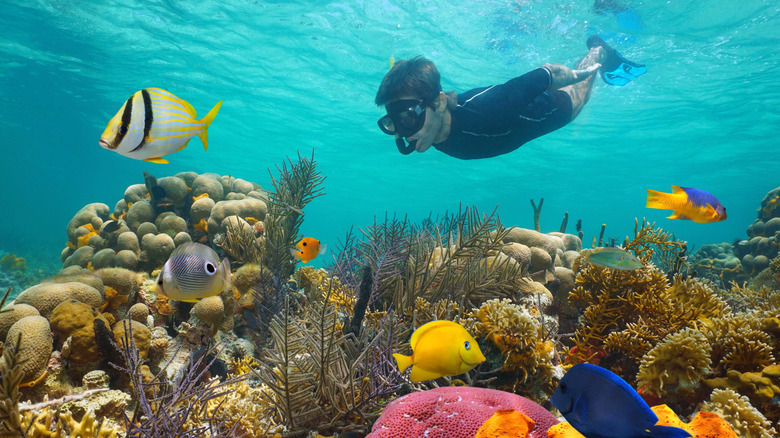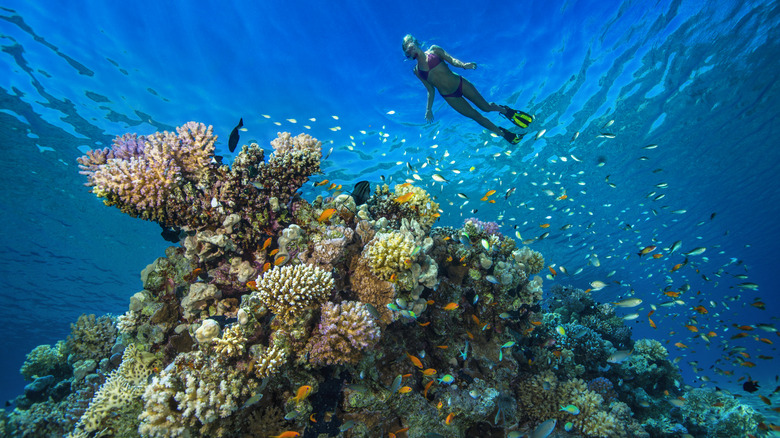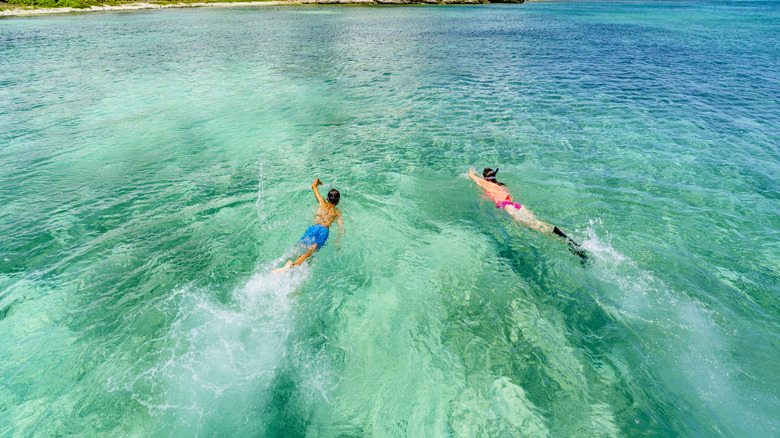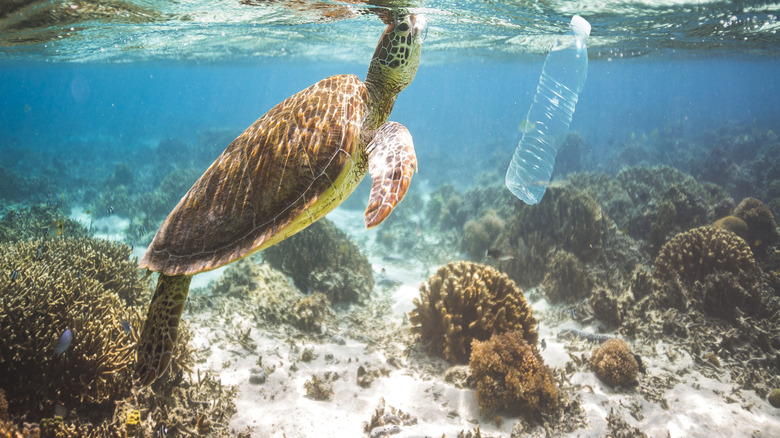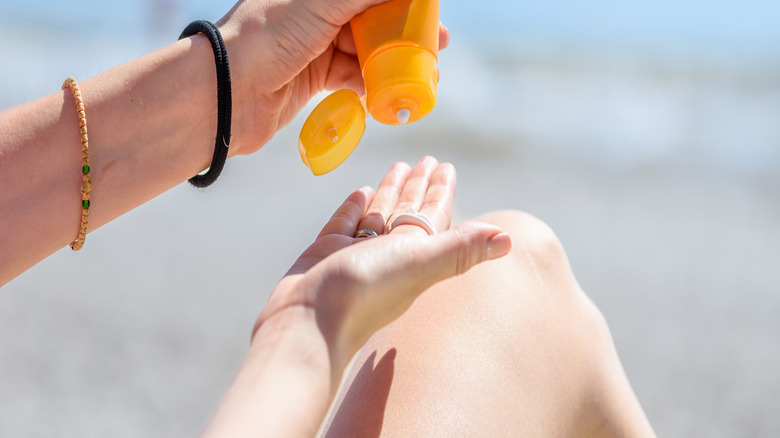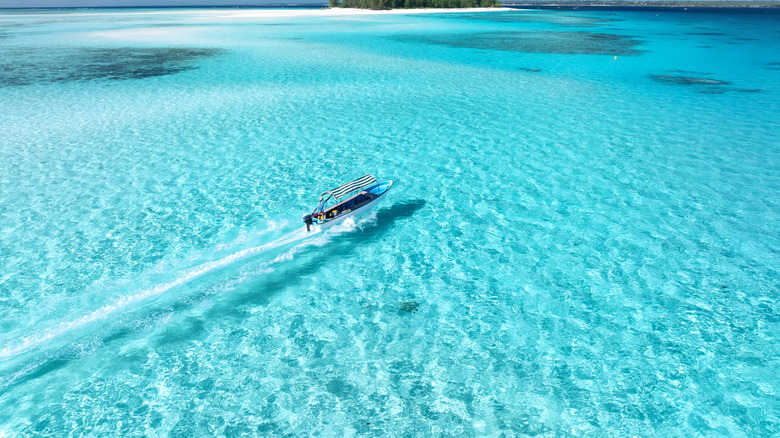How To Snorkel Near Coral Reefs (Without Hurting The Environment Or Yourself)
The first person to stick a hollowed-out branch in their mouth and plunge their face in the water deserves a round of applause. Now, thanks to flexible plastic tubes and watertight eyewear, pretty much anybody of any age can enjoy coasting on the water's surface while gazing beneath it. Do this activity in warm, shallow, tropical waters across the world, and you just might see a vibrant forest of colorful, clustered corals that don't swim but are no less alive than any fish. Much like other natural habitats we enjoy, it's up to us clever apes to do our best to preserve that life — and our own.
Long before the first person ever littered in the sea, there were corals. As a form of animal life, they have been around for over 500 million years and have made it through every phase of Earth's development since then. As a reference, coral predates the emergence of all plant life (470 million years ago), trees (390 million years ago), dinosaurs (about 245 million years ago), and mammals (225 million years ago). Coral reefs house 25% of all oceanic species and provide food to 4,000 species of fish, which, in turn, provide food to about 500 million people (per the Reef-World Foundation). In other words, corals deserve our respect and care.
But how do you respect and care for coral while wanting to snorkel and see it? It's easy, really, and boils down to the type of lesson you'd tell a toddler about a hot stove: Hands off. Safe snorkeling — both for you and the coral — involves touching nothing, leaving nothing, taking nothing, being careful of your clothing and chemical-ridden sunscreen, and proper boating practices in the local area.
Don't touch the coral or other wildlife
It's a basic human instinct to see a nice thing and touch the nice thing, but this most innocent of impulses can kill coral. Even just kicking up sand or sediment with your flippers can smother them, which is akin to a person trying to breathe in a smoke-filled room. Corals are animals, remember, and they respire oxygen just like fish, reptiles, mammals, and so on. It should go without saying that plucking one from the ocean bed is an absolute no-no, same as you (presumably) wouldn't go chasing a wild animal to collect it in a cage or scoop a bunch of reef fish into a net to take home. You also don't want to stand on coral to take a break from swimming.
Messing with coral can injure you, too. Reaching out to touch them or just brushing up against them can cause cuts, scrapes, and a burning, itchy feeling that can take up to months to heal — after all, they've got to protect themselves, too. There are also plenty of potentially dangerous creatures to be aware of when snorkeling, like jellyfish or stingrays to be aware of (especially if you step on them). Basically, when snorkeling, you should pretend that you're a ghost. You float by, observe, and leave no evidence of your passing, just like the hikers' "Leave no Trace" slogan. This is true even if you're in an artificial underwater attraction, like Florida's Guardians of the Reef snorkel trail, full of underwater statues meant to serve as future coral perches.
Practice swimming and wearing your gear away from the reef
Snorkeling is supposed to be a low-skill, low-bar activity, which is why it's so fun for so many people. But even though you could easily strap a mask and snorkel on your face and start paddling across the water's surface, it pays to do a bit of practice. One of the last things you should do while out and about in a coral reef is begin to check your gear and get yourself together. Go back to your boat to fix your equipment, be careful of kicking off sand or sediment with your flippers, and do not pause to stand on coral — all of these things are related to proper snorkeling pracices, and if you've got to practice swimming, you should do it away from a reef, wearing full gear or not.
In general, you should be fully prepared and confident before snorkeling. Get your mask prepped, make sure the tube works, check your fins, and toss on a life vest if you're not a strong swimmer. Don't use some kind of flotation device like an inner tube or noodle because those can get away from you. Forget about possibly looking dumb with a vest on. It's more important to keep yourself and the reef safe. Besides, if your mind is too focused on swimming properly and staying afloat, it'll be harder to appreciate the experience. You can wear a long-sleeve swimming top to prevent accidental skin contact or even a body suit if you're really worried about stingrays or jellyfish. No matter what: Practice away from the reef.
Don't take anything (except new trash)
There's only one exception to the "Touch Nothing" rule when snorkeling: new trash. By "new trash," we mean some kind of obvious, easily retrieved object like a plastic bottle or plastic bag that isn't tangled in coral or half-buried in sediment. If you see the edge of an old, salt-eaten, plastic child's shovel sticking out of the sand, don't go digging around coral or disturbing wildlife to fish it out. This might seem counterintuitive, but you could do more harm than good. Leave it as it is, and wait for proper cleanup crews to get it (you could always report it). Even if an animal like a sea turtle comes to you asking for help with fishing line coiled around it — which sadly happens more often than you might think — you should keep your distance and alert the local stranding network.
That being said, it's perfectly ok to pick up garbage in the surf or along the beach that has washed up away from coral, as a lot of trash often does. Cleanup crews are everywhere and sometimes involve nothing more complex than walking along the sand and looking for things that other people have thoughtlessly discarded or dropped. This is why, as a flipside to "Take Nothing" and "Touch Nothing" rules, we could add "Bring Nothing," especially single-use plastic items. Anything you bring snorkeling should go home with you. And if you happen to find any new, easily fetchable piece of trash that won't disturb the wildlife if removed, take it home and chuck it in the trash.
Avoid wearing reef-damaging sunscreen and clothing
Simply wearing sunscreen or sunblock can put coral in danger. Certain types of protective lotions contain chemicals that can harm coral reefs and marine life. Three active ingredients, in particular, contain an array of substances that are not reef-safe: avobenzone, oxybenzone, and octinoxate. This is true even if a product advertises itself as "reef-friendly" or something similar. Don't trust it. You've got to check the individual ingredients.
Instead, find sunscreen or sunblock that only uses zinc oxide or titanium dioxide. These substances are used in physical sunscreen, aka mineral-based sunscreen, not chemical. Mineral sunscreens sit on the skin's surface and physically block UV rays rather than dissipate them through a chemical reaction within your skin.
Aside from taking care to wear the correct sunscreen, you should also avoid wearing gloves or kneepads. While gloves will protect your skin from coral cuts and stings, they make snorkelers and divers incautious. Gloves will make it easier to reach out and touch things, and kneepads make it easy to pause and kneel on coral. Rather than use equipment that can indirectly encourage carelessness, it's better to snorkel in a disciplined, educated, and conscientious way that depends on self-control and cutting off coral damage at its human-caused roots. This kind of mindful approach will help damaged reefs heal as well as preserve pristine reefs, like those near the relatively untouched Indian island of Minicoy, off the coast of Kerala.
Be careful about boating regulations, diving locations, and local laws
Finally, it's important to remember that each and every snorkeling rule for an individual applies to that person's boat and logistical entry into the water. Because you shouldn't stand on coral, you also shouldn't chuck an anchor onto a reef. Snorkeling spots are typically characterized by ultra-clear, turquoise seas, so take advantage and drop anchor onto a visibly sandy ocean floor. Better yet, tie off your boat at buoys or any designated mooring available — they exist to ensure reef safety. This is also safer for you because it means that you're being as rule-abiding as possible. In case you need to get back to your boat quickly, you shouldn't wander too far, in general.
It's also important to read up on rules and regulations regarding snorkeling within whatever area you're headed, rather than just storming out onto the seas willy-nilly. Thailand, for instance, has laws about wearing mandatory life vests and snorkeling with at least 6.5 feet of water between you and the reef. It's also prohibited to touch coral or other sea life and even to kick up sand or sediment. In Hawaii, it's illegal to snorkel without placing a diver-down flag in the area for other boaters to see. So check the local laws to keep your boat, your person, and the reefs safe.
